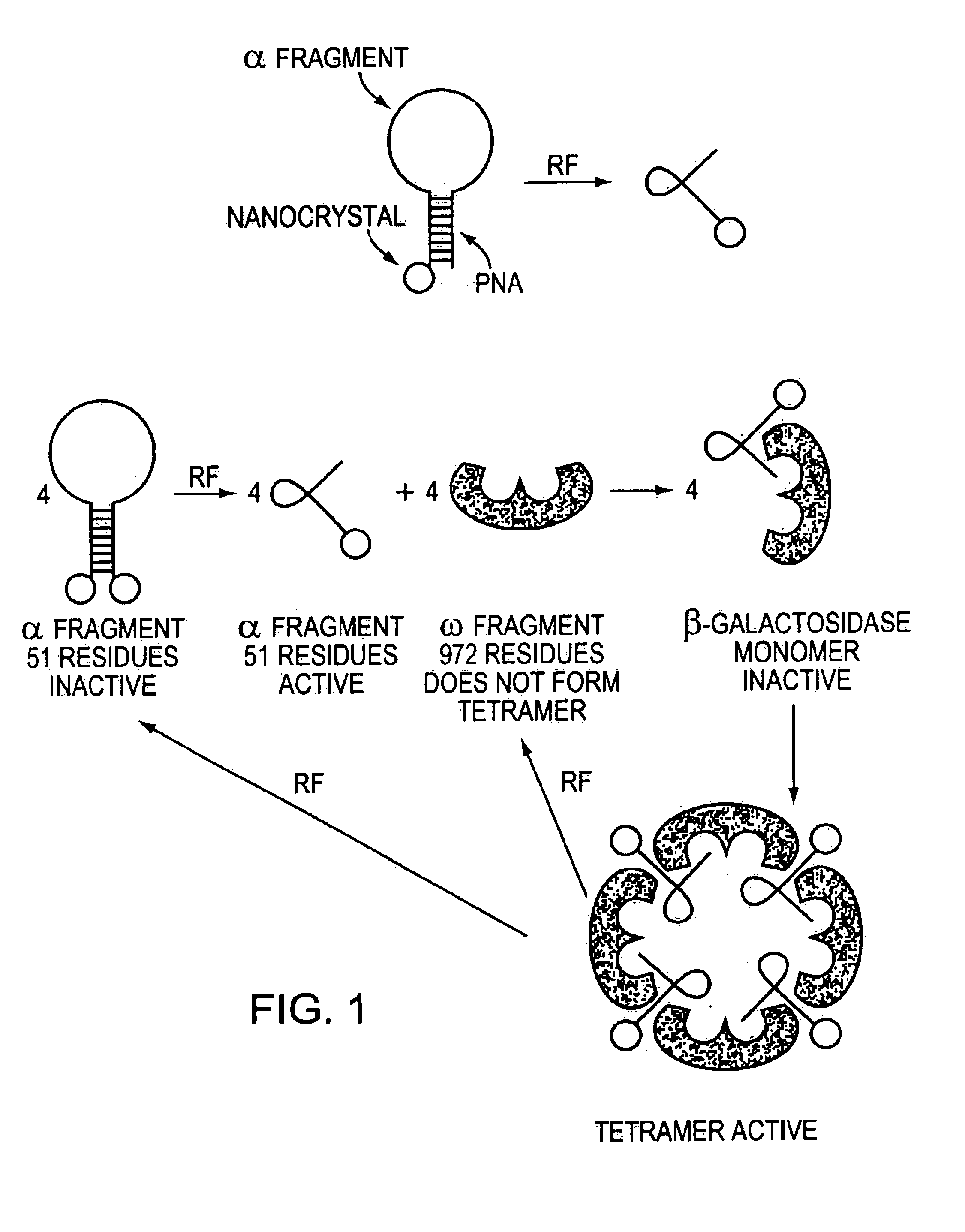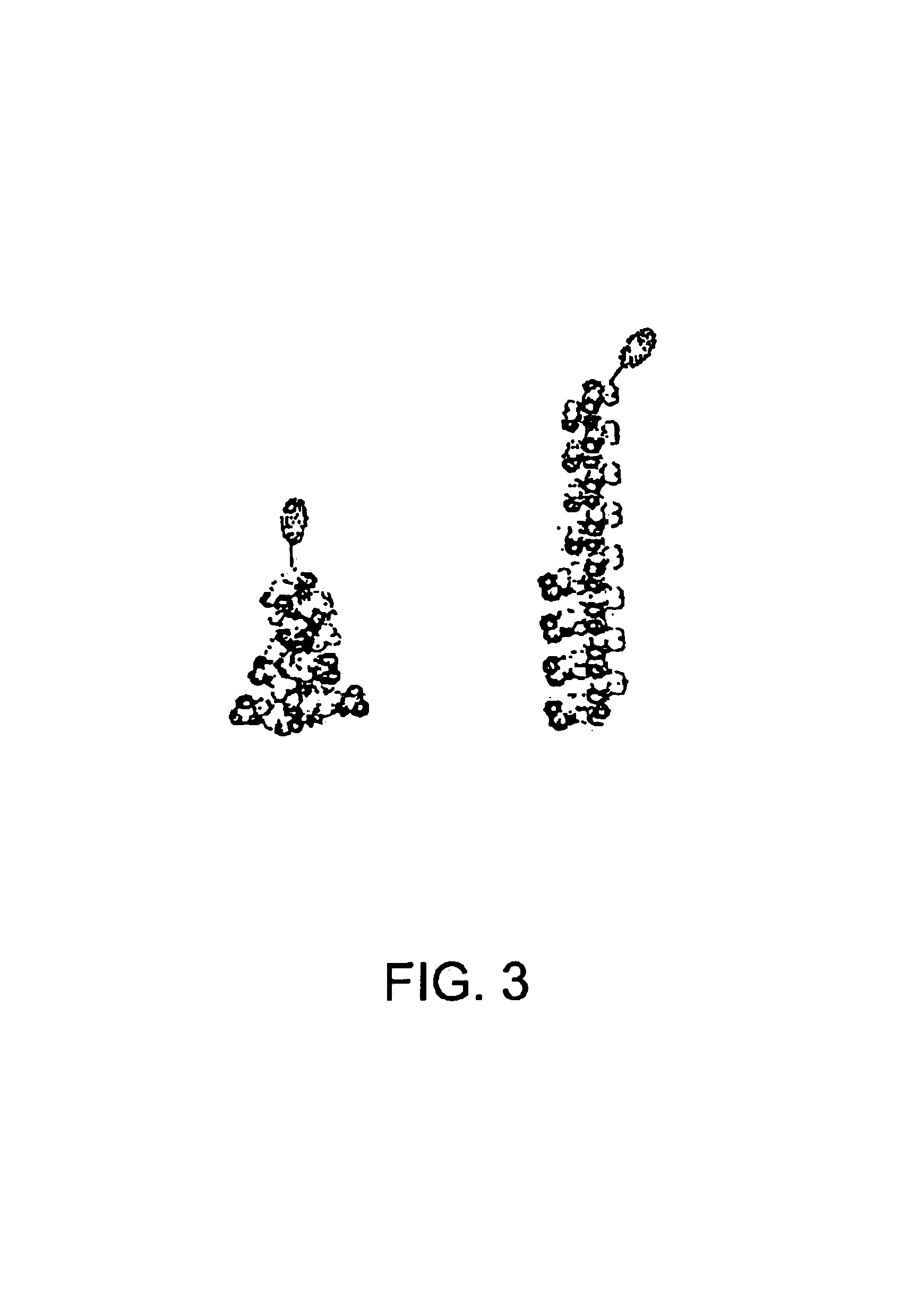Direct, externally imposed control of polypeptides
a polypeptide and external force technology, applied in the direction of peptide sources, cell components, instruments, etc., can solve the problems of inability to precisely control individual molecular entities or portions thereof, change in the structure or stability of proteins, and change in the structural and functional properties of proteins
- Summary
- Abstract
- Description
- Claims
- Application Information
AI Technical Summary
Benefits of technology
Problems solved by technology
Method used
Image
Examples
example 1
Methods and Compositions for Associating Modulators with Proteins
[0100]Ribonuclease S was associated with a modulator, such as a gold nanocrystal according to the following non-limiting method. A portion of the protein Ribonuclease S, the S-peptide, was synthesized so that it contains a cysteine residue and a spacer of two extra amino acids (glycines). The cysteine residue was on the N-terminus of the S-peptide. The modulator to be associated with the S-peptide was a gold nanocrystal that is 1.4 nm in diameter and is soluble in the solvents in which the Ribonuclease S is functional (for example phosphate buffer solution, which contains 13.7 mM NaCl, 2.7 mM KCl, 4.3 mM NaH2PO4, 1.4 mM KH2PO4). The modulator had a ligand maleimide group on its surface that can react with the cysteine residue on the S-peptide. The modulator was incubated with the S-peptide to permit the reaction of the maleimide with the cysteine, resulting in a covalent linkage between the two. The modulator-S-peptide...
example 2
Direct Inductive Heating of a Protein Associated with a Modulator in Solution
[0101]In this example, ribonuclease S was associated with a gold nanocrystal modulator (the system described in Example 1). The activity of the enzyme was controlled by induction heating of the modulator using an alternating magnetic field. The frequency of the alternating magnetic field was 1 GHz in the radiofrequency range. Accordingly, the alternating magnetic field is referred to as a radiofrequency magnetic field (RFMF). The modulator S-peptide and S-protein complex was incubated with the substrate, polyC, in solution at 37° C. The tube containing the sample was placed in a coil inside which the RFMF was generated and switched on. Activity was monitored by measuring the amount of digested polyC in the solution. PolyC was purified from the rest of the sample by precipitation with trichloroacetic acid (TCA). The activity was the amount of digested polyC, which is determined by the optical absorption of t...
example 3
Radio Frequency Regulation of Enzymatic Activity of Ribonuclease S
[0103]The ability to externally and remotely control biological systems at a higher precision with greater selectivity is a long-term goal for next generation of biological regulations. It is now possible to covalently link biological macromolecules with inorganic conducting particles, such as gold nanoparticle, or semi-conducting nanoparticles and have them respond to external electronic signals. The enzymatic activity if RNase S was precisely and selectively controlled by covalently attaching a single gold nanoparticle through a cysteine residue on the S-peptide of the ribonuclease S (RNase S) and then interacting it with the S-protein (FIG. 11). As shown in FIG. 11, the S-peptide was appended with three amino acids, two glycines and a terminal cysteine. It was subsequently attached to a nanocrystal (Au-S18) via the cysteine. The Au-S18 and S-peptide complex was active in that it was able to hydrolyze RNA. Under the...
PUM
| Property | Measurement | Unit |
|---|---|---|
| diameters | aaaaa | aaaaa |
| total length | aaaaa | aaaaa |
| total length | aaaaa | aaaaa |
Abstract
Description
Claims
Application Information
 Login to View More
Login to View More - R&D
- Intellectual Property
- Life Sciences
- Materials
- Tech Scout
- Unparalleled Data Quality
- Higher Quality Content
- 60% Fewer Hallucinations
Browse by: Latest US Patents, China's latest patents, Technical Efficacy Thesaurus, Application Domain, Technology Topic, Popular Technical Reports.
© 2025 PatSnap. All rights reserved.Legal|Privacy policy|Modern Slavery Act Transparency Statement|Sitemap|About US| Contact US: help@patsnap.com



